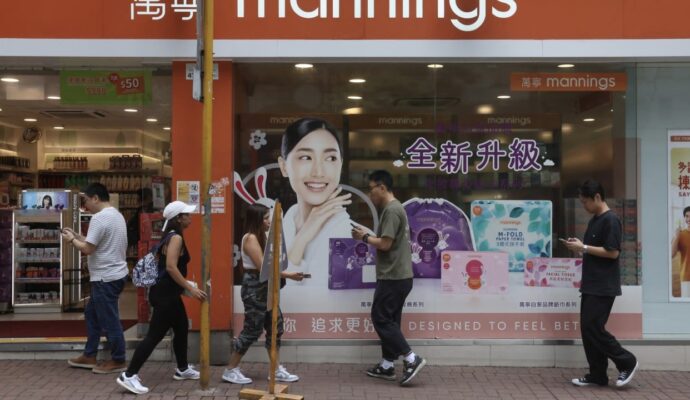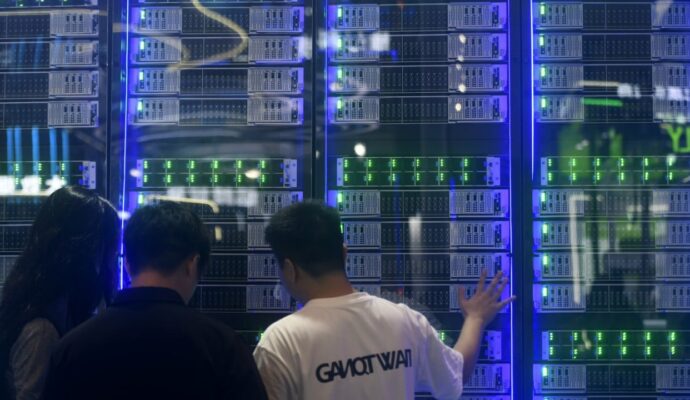
The chipmakers Nvidia and AMD have agreed to give the US government 15% of their revenue from advanced chips sold to China in return for export licences to the key market.
The unprecedented move, an apparent reversal of US national security restrictions on the chip sales, signalled an easing in the US-China trade war.
Donald Trump has weaponised trade restrictions and tariffs to bring business to US shores. However, the quid pro quo arrangement, first reported by the Financial Times, is potentially unconstitutional.
The arrangement will lead to Nvidia giving 15% of its revenue from Chinese sales of its H20 chips, and AMD giving 15% of revenue from Chinese sales of its MI308 chips, according to reports citing US officials.
The US government has for several years sought to limit supplies of technology to China that could be used in ways that threaten US national security, especially chips that can power artificial intelligence development and weapons.
Nvidia’s chips are a major driver of the AI boom, highly sought-after by both China and the US. Beijing has repeatedly criticised the chip restrictions and accused the US of using tech and trade to “maliciously contain and suppress China”.
The H20 and MI308 chips were banned from sale to China in April, despite the lower-powered H20 being designed specifically to abide by restrictions introduced by the Biden administration.
However, last month Trump rolled back the bans, and last week the commerce department reportedly started issuing export licences for the H20 – a move that analysts linked to China’s easing of rare earth export restrictions, and to the revenue-sharing agreement revealed on Sunday.
In an apparent lobbying effort to address the restrictions, Nvidia’s chief executive, Jensen Huang, had made visits to Trump and officials in Beijing in recent months, meeting the US president as recently as Wednesday.
Trump has praised Huang and Nvidia, which in July became the first company to have its market value pass $4tn (£2.97tn), even as it navigated the US-China trade war and other industry turbulence, including Trump’s threatened 100% tariff on foreign semiconductors.
In a statement after the Financial Times report, Nvidia said: “We follow rules the US government sets for our participation in worldwide markets. While we haven’t shipped H20 to China for months, we hope export control rules will let America compete in China and worldwide.”
AMD has not commented on the deal.
Nvidia’s statement echoed comments by the US commerce secretary, Howard Lutnick, last month, that it was in the US’s interests to have China using American technology, and that the H20 was Nvidia’s “fourth-best chip”. The deal has alarmed analysts, however.
after newsletter promotion
Peter Harrell, the Biden administration’s White House senior director for international economics, said on social media: “In addition to the policy problems with just charging Nvidia and AMD a 15% share of revenues to sell advanced chips in China, the US constitution flatly forbids export taxes.”
Ilaria Carrozza, a senior researcher at the Peace Research Institute Oslo, said that the export controls were still in place but that the deal threatened the credibility of the controls the trust of other nations – particularly in the EU and east Asia – whom the US had lobbied to impose restrictions.
“If we assume these national security restrictions can be bypassed by paying some sort of fee to the government … then how can we keep these export controls credible?” she told the Guardian.
A truce in the US-China tariff-war is due to end on Tuesday, with no extension yet announced despite officials from Beijing saying both sides were working towards one in recent talks.
In a note on Monday, Goldman Sachs said that US companies had absorbed most of the costs of other tariffs imposed by Trump on various nations’ exports but that consumers would soon be bearing the brunt.
In June, US businesses took on about 64% of the costs of the tariffs, and consumers 22%, but that was expected to flip, with the consumers’ share expected to increase to 67%.
With Reuters


